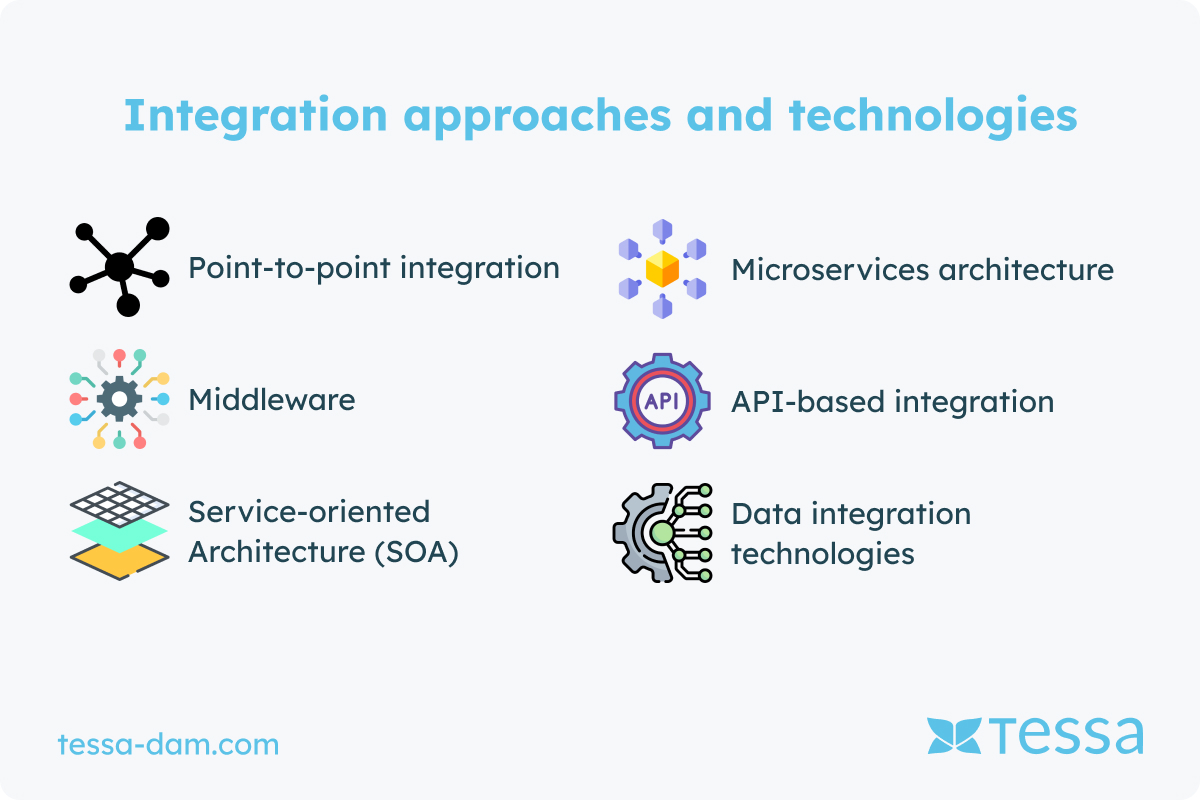Introduction
In the context of software, integration refers to the process of connecting and merging various software components, systems, or applications to facilitate seamless interaction and exchange of data and functionalities. This process involves the technical implementation of interfaces, protocols, and communication mechanisms to ensure interoperable collaboration between the individual elements. Integration can occur at various levels, including connecting hardware components, merging data from different sources, or combining software modules into a comprehensive application. The goal of integration is to improve the efficiency, performance, and functionality of software solutions by enabling them to communicate and collaborate seamlessly.
Integration Approaches and Technologies
In an increasingly interconnected world, integration approaches and technologies are crucial for companies requiring smooth interaction between various systems and applications. Here, we take a closer look at some key approaches:
Point-to-Point-Integration
Point-to-Point integration has long been the standard approach for connecting systems. In this approach, direct connections are established between systems to exchange data. While initially straightforward, this can lead to a cluttered and difficult-to-maintain infrastructure. Each new connection requires additional code and increases the complexity of the system.
Middleware
Middleware is software that mediates between different applications or systems. It acts as a kind of "glue" that facilitates communication without requiring direct point-to-point connections. By using middleware, companies can create a more flexible and scalable integration architecture.
Service-Oriented Architecture (SOA)
SOA is an architectural approach aimed at organizing applications as a collection of independent services that communicate via standardized interfaces. Each service provides specific functions and can be called upon by other services to support complex business processes. SOA enables improved code reusability and faster development of new applications.
Microservices Architecture
The microservices architecture is an evolution of SOA, where applications are divided into small, self-contained services, each fulfilling a specific business function. Each microservice can be developed, deployed, and scaled independently, allowing for greater flexibility and agility.
API-Based Integration
APIs serve as interfaces between different applications or services, allowing them to communicate and exchange data. API-based integration enables seamless connection between systems and applications, facilitating the development of cross-platform solutions.
Data Integration Technologies
Data integration technologies encompass a variety of tools and methods for extracting, transforming, and loading (ETL) data from different sources. These technologies allow companies to consolidate data from heterogeneous sources and create a unified data foundation for making informed decisions.
Challenges and solutions in integration
Software integration poses a variety of challenges for companies to overcome in order to ensure smooth operations and optimal performance. One of the main challenges is the complexity and interoperability of various systems and platforms. Each system has its own data structures and communication protocols, making integration a complex task. Solutions for this include the use of middleware, which acts as a mediation layer between systems and simplifies data exchange.
Another challenge is ensuring data consistency and security across integrated systems. Integrating different systems can lead to inconsistencies in data, which can result in errors and loss of trust among users. Solutions for this include implementing data validation and security mechanisms, as well as using encryption technologies to ensure the integrity and confidentiality of data.
Scalability and performance of integrated systems are also crucial. As companies grow, integrated systems must be able to handle increasing numbers of users and data without sacrificing performance. Solutions for this include using cloud computing and distributed system architectures to improve scalability and distribute the load on systems.
Monitoring and troubleshooting integrated systems is an ongoing process that requires continuous attention. By implementing monitoring tools and automated troubleshooting mechanisms, companies can detect and resolve potential issues early on, before they impact operations.
Finally, compliance and regulation are important aspects to consider in integration. Companies must ensure that integrated systems comply with applicable regulations and standards, especially in heavily regulated industries such as healthcare or financial services. Solutions for this include implementing compliance checks and audits, as well as adhering to industry standards and guidelines.
Overall, successful software integration requires careful planning, implementation, and monitoring to overcome the challenges mentioned above and ensure seamless interaction between different systems and platforms.
Best practices for successful integration
To ensure successful integration of software and overcome challenges, certain best practices are essential. Here are some proven approaches that companies should consider:
Modular and loosely coupled architecture: Divide software into independent components that are easy to develop, maintain, and scale. Loose coupling between modules allows changes to be made in one area without affecting other parts of the system.
Use of standard protocols and formats: Using established standards for data communication and representation facilitates integration with other systems significantly. Standard protocols like HTTP(S), REST, or SOAP, and data formats like JSON or XML enable seamless communication between different platforms and applications.
Implementation of integration patterns: Integration patterns are proven solutions for common integration challenges. By using patterns such as EAI (Enterprise Application Integration), ETL (Extract, Transform, Load), or Pub/Sub (Publish/Subscribe), companies can efficiently address complex integration challenges.
Automation of integration processes: Automating integration processes reduces manual effort and minimizes human errors. By using automation tools for deployment, configuration, monitoring, and troubleshooting, companies can improve the efficiency and reliability of their integration processes.
Implementation of testing and monitoring: Testing and monitoring are essential components of a successful integration project. By conducting unit tests, integration tests, and end-to-end tests, potential issues can be identified and resolved early on. Continuous monitoring allows for the monitoring of the performance and availability of integrated systems and enables rapid response when needed.
Applications and case studies
Software integration is crucial in various industries and use cases. Here are some specific examples and case studies that illustrate the challenges, solutions, and successes in integration:
E-Commerce Platforms: Integration of various systems and platforms is essential in the e-commerce industry to provide a seamless shopping experience. Companies like Amazon and eBay integrate payment processing, inventory management systems, CRM systems, and shipping services to streamline the entire purchasing process and enhance customer satisfaction.
Enterprise Applications: Large companies rely on the integration of ERP (Enterprise Resource Planning), CRM (Customer Relationship Management), and HRM (Human Resource Management) systems to optimize their business processes. By integrating these systems, they can seamlessly exchange data between departments and gain a holistic view of their corporate data.
Cloud Integration: Companies are increasingly adopting cloud-based solutions to optimize their IT infrastructure and reduce costs. By integrating on-premises and cloud systems, they can improve the scalability, flexibility, and agility of their IT infrastructure. For example, companies integrate their local databases with cloud-based analytics platforms to efficiently process large amounts of data and make informed business decisions.
IoT Integration: The Internet of Things (IoT) enables the networking of physical devices and sensors to collect and analyze real-time data. By integrating IoT devices with enterprise systems, companies can unlock new business opportunities and develop innovative products and services. For example, companies use IoT sensors in production, logistics, and supply chain to optimize processes and reduce costs.
Conclusion
A critical component of the digital transformation
In conclusion, software integration is a critical component of the digital transformation of businesses, enabling them to respond to changing market conditions, explore new business opportunities, and enhance competitiveness. By implementing best practices and leveraging innovative technologies, companies can fully realize the benefits of integration and strengthen their position in the digital age.





